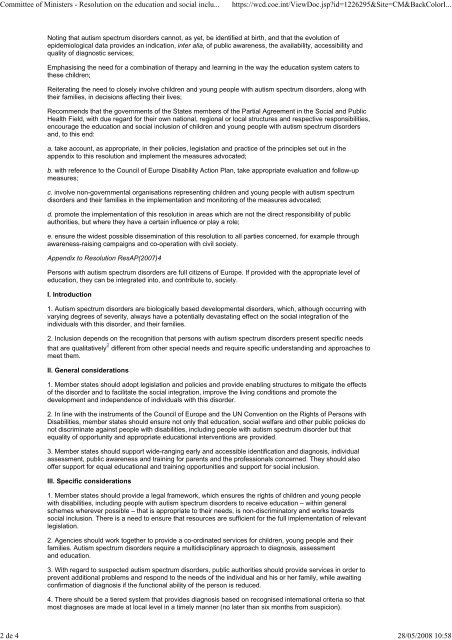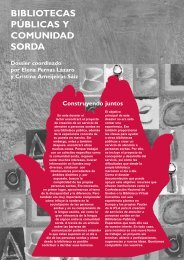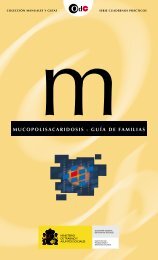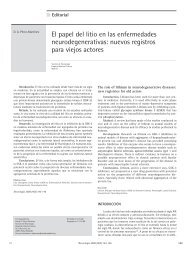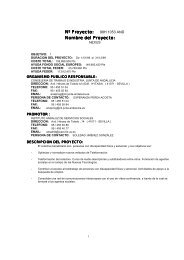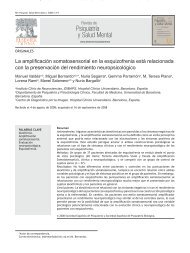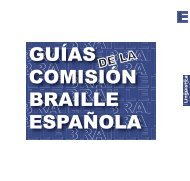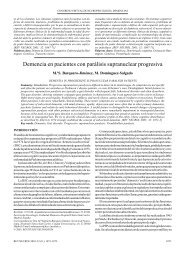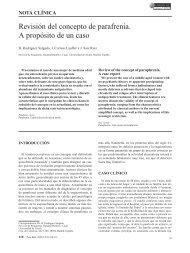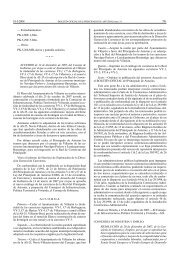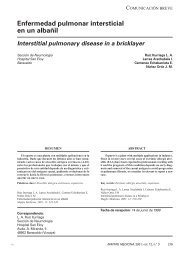Committee of Ministers - Resolution on the education and soci...
Committee of Ministers - Resolution on the education and soci...
Committee of Ministers - Resolution on the education and soci...
Create successful ePaper yourself
Turn your PDF publications into a flip-book with our unique Google optimized e-Paper software.
<str<strong>on</strong>g>Committee</str<strong>on</strong>g> <str<strong>on</strong>g>of</str<strong>on</strong>g> <str<strong>on</strong>g>Ministers</str<strong>on</strong>g> - <str<strong>on</strong>g>Resoluti<strong>on</strong></str<strong>on</strong>g> <strong>on</strong> <strong>the</strong> educati<strong>on</strong> <strong>and</strong> <strong>soci</strong>al inclu... https://wcd.coe.int/ViewDoc.jsp?id=1226295&Site=CM&BackColorI...<br />
2 de 4<br />
Noting that autism spectrum disorders cannot, as yet, be identified at birth, <strong>and</strong> that <strong>the</strong> evoluti<strong>on</strong> <str<strong>on</strong>g>of</str<strong>on</strong>g><br />
epidemiological data provides an indicati<strong>on</strong>, inter alia, <str<strong>on</strong>g>of</str<strong>on</strong>g> public awareness, <strong>the</strong> availability, accessibility <strong>and</strong><br />
quality <str<strong>on</strong>g>of</str<strong>on</strong>g> diagnostic services;<br />
Emphasising <strong>the</strong> need for a combinati<strong>on</strong> <str<strong>on</strong>g>of</str<strong>on</strong>g> <strong>the</strong>rapy <strong>and</strong> learning in <strong>the</strong> way <strong>the</strong> educati<strong>on</strong> system caters to<br />
<strong>the</strong>se children;<br />
Reiterating <strong>the</strong> need to closely involve children <strong>and</strong> young people with autism spectrum disorders, al<strong>on</strong>g with<br />
<strong>the</strong>ir families, in decisi<strong>on</strong>s affecting <strong>the</strong>ir lives;<br />
Recommends that <strong>the</strong> governments <str<strong>on</strong>g>of</str<strong>on</strong>g> <strong>the</strong> States members <str<strong>on</strong>g>of</str<strong>on</strong>g> <strong>the</strong> Partial Agreement in <strong>the</strong> Social <strong>and</strong> Public<br />
Health Field, with due regard for <strong>the</strong>ir own nati<strong>on</strong>al, regi<strong>on</strong>al or local structures <strong>and</strong> respective resp<strong>on</strong>sibilities,<br />
encourage <strong>the</strong> educati<strong>on</strong> <strong>and</strong> <strong>soci</strong>al inclusi<strong>on</strong> <str<strong>on</strong>g>of</str<strong>on</strong>g> children <strong>and</strong> young people with autism spectrum disorders<br />
<strong>and</strong>, to this end:<br />
a. take account, as appropriate, in <strong>the</strong>ir policies, legislati<strong>on</strong> <strong>and</strong> practice <str<strong>on</strong>g>of</str<strong>on</strong>g> <strong>the</strong> principles set out in <strong>the</strong><br />
appendix to this resoluti<strong>on</strong> <strong>and</strong> implement <strong>the</strong> measures advocated;<br />
b. with reference to <strong>the</strong> Council <str<strong>on</strong>g>of</str<strong>on</strong>g> Europe Disability Acti<strong>on</strong> Plan, take appropriate evaluati<strong>on</strong> <strong>and</strong> follow-up<br />
measures;<br />
c. involve n<strong>on</strong>-governmental organisati<strong>on</strong>s representing children <strong>and</strong> young people with autism spectrum<br />
disorders <strong>and</strong> <strong>the</strong>ir families in <strong>the</strong> implementati<strong>on</strong> <strong>and</strong> m<strong>on</strong>itoring <str<strong>on</strong>g>of</str<strong>on</strong>g> <strong>the</strong> measures advocated;<br />
d. promote <strong>the</strong> implementati<strong>on</strong> <str<strong>on</strong>g>of</str<strong>on</strong>g> this resoluti<strong>on</strong> in areas which are not <strong>the</strong> direct resp<strong>on</strong>sibility <str<strong>on</strong>g>of</str<strong>on</strong>g> public<br />
authorities, but where <strong>the</strong>y have a certain influence or play a role;<br />
e. ensure <strong>the</strong> widest possible disseminati<strong>on</strong> <str<strong>on</strong>g>of</str<strong>on</strong>g> this resoluti<strong>on</strong> to all parties c<strong>on</strong>cerned, for example through<br />
awareness-raising campaigns <strong>and</strong> co-operati<strong>on</strong> with civil <strong>soci</strong>ety.<br />
Appendix to <str<strong>on</strong>g>Resoluti<strong>on</strong></str<strong>on</strong>g> ResAP(2007)4<br />
Pers<strong>on</strong>s with autism spectrum disorders are full citizens <str<strong>on</strong>g>of</str<strong>on</strong>g> Europe. If provided with <strong>the</strong> appropriate level <str<strong>on</strong>g>of</str<strong>on</strong>g><br />
educati<strong>on</strong>, <strong>the</strong>y can be integrated into, <strong>and</strong> c<strong>on</strong>tribute to, <strong>soci</strong>ety.<br />
I. Introducti<strong>on</strong><br />
1. Autism spectrum disorders are biologically based developmental disorders, which, although occurring with<br />
varying degrees <str<strong>on</strong>g>of</str<strong>on</strong>g> severity, always have a potentially devastating effect <strong>on</strong> <strong>the</strong> <strong>soci</strong>al integrati<strong>on</strong> <str<strong>on</strong>g>of</str<strong>on</strong>g> <strong>the</strong><br />
individuals with this disorder, <strong>and</strong> <strong>the</strong>ir families.<br />
2. Inclusi<strong>on</strong> depends <strong>on</strong> <strong>the</strong> recogniti<strong>on</strong> that pers<strong>on</strong>s with autism spectrum disorders present specific needs<br />
that are qualitatively 2 different from o<strong>the</strong>r special needs <strong>and</strong> require specific underst<strong>and</strong>ing <strong>and</strong> approaches to<br />
meet <strong>the</strong>m.<br />
II. General c<strong>on</strong>siderati<strong>on</strong>s<br />
1. Member states should adopt legislati<strong>on</strong> <strong>and</strong> policies <strong>and</strong> provide enabling structures to mitigate <strong>the</strong> effects<br />
<str<strong>on</strong>g>of</str<strong>on</strong>g> <strong>the</strong> disorder <strong>and</strong> to facilitate <strong>the</strong> <strong>soci</strong>al integrati<strong>on</strong>, improve <strong>the</strong> living c<strong>on</strong>diti<strong>on</strong>s <strong>and</strong> promote <strong>the</strong><br />
development <strong>and</strong> independence <str<strong>on</strong>g>of</str<strong>on</strong>g> individuals with this disorder.<br />
2. In line with <strong>the</strong> instruments <str<strong>on</strong>g>of</str<strong>on</strong>g> <strong>the</strong> Council <str<strong>on</strong>g>of</str<strong>on</strong>g> Europe <strong>and</strong> <strong>the</strong> UN C<strong>on</strong>venti<strong>on</strong> <strong>on</strong> <strong>the</strong> Rights <str<strong>on</strong>g>of</str<strong>on</strong>g> Pers<strong>on</strong>s with<br />
Disabilities, member states should ensure not <strong>on</strong>ly that educati<strong>on</strong>, <strong>soci</strong>al welfare <strong>and</strong> o<strong>the</strong>r public policies do<br />
not discriminate against people with disabilities, including people with autism spectrum disorder but that<br />
equality <str<strong>on</strong>g>of</str<strong>on</strong>g> opportunity <strong>and</strong> appropriate educati<strong>on</strong>al interventi<strong>on</strong>s are provided.<br />
3. Member states should support wide-ranging early <strong>and</strong> accessible identificati<strong>on</strong> <strong>and</strong> diagnosis, individual<br />
assessment, public awareness <strong>and</strong> training for parents <strong>and</strong> <strong>the</strong> pr<str<strong>on</strong>g>of</str<strong>on</strong>g>essi<strong>on</strong>als c<strong>on</strong>cerned. They should also<br />
<str<strong>on</strong>g>of</str<strong>on</strong>g>fer support for equal educati<strong>on</strong>al <strong>and</strong> training opportunities <strong>and</strong> support for <strong>soci</strong>al inclusi<strong>on</strong>.<br />
III. Specific c<strong>on</strong>siderati<strong>on</strong>s<br />
1. Member states should provide a legal framework, which ensures <strong>the</strong> rights <str<strong>on</strong>g>of</str<strong>on</strong>g> children <strong>and</strong> young people<br />
with disabilities, including people with autism spectrum disorders to receive educati<strong>on</strong> – within general<br />
schemes wherever possible – that is appropriate to <strong>the</strong>ir needs, is n<strong>on</strong>-discriminatory <strong>and</strong> works towards<br />
<strong>soci</strong>al inclusi<strong>on</strong>. There is a need to ensure that resources are sufficient for <strong>the</strong> full implementati<strong>on</strong> <str<strong>on</strong>g>of</str<strong>on</strong>g> relevant<br />
legislati<strong>on</strong>.<br />
2. Agencies should work toge<strong>the</strong>r to provide a co-ordinated services for children, young people <strong>and</strong> <strong>the</strong>ir<br />
families. Autism spectrum disorders require a multidisciplinary approach to diagnosis, assessment<br />
<strong>and</strong> educati<strong>on</strong>.<br />
3. With regard to suspected autism spectrum disorders, public authorities should provide services in order to<br />
prevent additi<strong>on</strong>al problems <strong>and</strong> resp<strong>on</strong>d to <strong>the</strong> needs <str<strong>on</strong>g>of</str<strong>on</strong>g> <strong>the</strong> individual <strong>and</strong> his or her family, while awaiting<br />
c<strong>on</strong>firmati<strong>on</strong> <str<strong>on</strong>g>of</str<strong>on</strong>g> diagnosis if <strong>the</strong> functi<strong>on</strong>al ability <str<strong>on</strong>g>of</str<strong>on</strong>g> <strong>the</strong> pers<strong>on</strong> is reduced.<br />
4. There should be a tiered system that provides diagnosis based <strong>on</strong> recognised internati<strong>on</strong>al criteria so that<br />
most diagnoses are made at local level in a timely manner (no later than six m<strong>on</strong>ths from suspici<strong>on</strong>).<br />
28/05/2008 10:58


